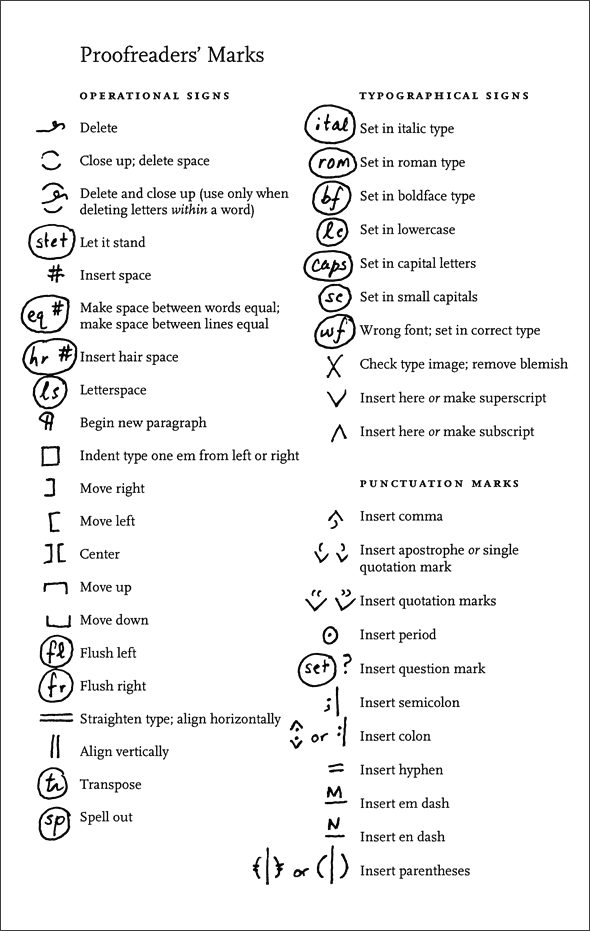Although most editing and proofreading are performed today using the ‘Track Changes’ feature of Microsoft Word or other commenting tools, you may encounter traditional proofreading marks and symbols on a hardcopy document. In desktop publishing, it is important to understand the meaning of proofreaders’ marks. Both editors/proofreaders and clients, regardless of their backgrounds, should have the same standard marks for easy communication.

Although most editing and proofreading are performed today using the ''Track-Changes'' feature of Microsoft Word or other commenting tools, you may encounter traditional proofreading marks and symbols on a hardcopy document. In desktop publishing, it is important to understand the meaning of proofreaders’ marks. Both editors, proofreaders, and clients, regardless of their backgrounds, should have the same standard marks for easy communication. That is why a consistent style and common proofreading marks and symbols should be used. These marks and symbols are considered the language that editors and proofreaders speak when they edit or proofread a hardcopy document.
As we discussed in the ‘‘The Difference Between Proofreading and Editing’’ article, the purpose of proofreading is to correct all errors in grammar, punctuation, syntax, and spelling in a manuscript. To confirm whether the final version of one’s manuscript contains any minor errors, you need proofreading. However, editing requires extra effort from an editor than does proofreading, because editing aims to improve the academic quality of your paper. Thus, editing involves improvement of the content, overall structure, quality of findings and analysis, simplicity, and referencing of the paper. Editing also aims to correct all errors in grammar, typography, punctuation, syntax, and spelling in a manuscript. In this sense, editing encompasses proofreading; however, strictly speaking, proofreading is the last stage before printing or delivery to the client. In hardcopy proofreading, editors and proofreaders use specific proofreaders’ marks to communicate their revisions.
If you have ever had a hardcopy paper proofread, you are probably familiar with the unexpected typology of your proofreader. The revised version of your document is returned with symbols that seem to be from a different language.
In a revised hardcopy version of a paper, all edits are visibly marked, including corrections, suggestions, and comments. These strange symbols and marks, left by proofreaders to highlight where changes need to be made in the text, allow you to notice all corrections and suggestions.
Proofreaders’ marks (also known as proofreading marks) are symbols and abbreviations for correcting typeset pages. The editors and proofreaders place these marks in the margins and in corresponding lines of text. These symbols and marks referring to comments about and suggestions for revisions appear in the margins and text of your manuscript.
In hardcopy proofreading, corrections and suggestions typically appear in the left or right margins, beside the line containing the error. A mark or symbol is also placed in the text to indicate where corrections and changes need to be made. A caret (^), for instance, indicates an addition, whereas a line through the text indicates a deletion or replacement. Proofreading marks are generally written in red ink for the best visibility.
Here is a list of the most common proofreaders’ marks for your reference (the list is taken from The Chicago Manual of Style Online):

(Source: The Chicago Manual of Style Online)
As discussed above, a revised version of a document, full of strange symbols and abbreviations, may seem to have been translated into another language. Understanding this strange language or decrypting the suggested changes might take hours and maybe time-consuming and challenging. It does not have to be anymore, thanks to the ''Track Changes'' function of Microsoft Word. The ''Track Changes'' function in Microsoft Word is a very handy tool for tracking all changes, corrections, edits, and even suggestions and comments by your editor or proofreader.
With this function, your document is returned with all edits visibly marked. All of the edits, including corrections, suggestions, and comments, via the ‘Track Changes’ function, appear in the margins of a revised paper. It is very easy to notice, follow, accept, or reject all the changes and suggestions in the paper. With a tracked paper, you also see some essential comments by the editor or proofreader on the right-hand side of the page. To read more about the ‘Track Changes’ function in Microsoft Word, click here.
Best Edit & Proof expert editors aim to provide your manuscripts with proper scholarly and academic tone and style. They will significantly improve the chances of having your research manuscript accepted for publishing. They provide subject-area proofreading and editing services in several fields categorized under various disciplines. With our extensive knowledge and expertise, we will help you find the right tone and style for your manuscript.
If you need our subject-area editors to format your manuscripts, giving you the fundamental rules for formatting your manuscripts as described in your guidelines, such as APA, MLA, or Chicago/Turabian styles, then contact us. At Best Edit & Proof, our proofreaders and editors edit every type of academic paper. We have a user-friendly website and a simplified ordering process.
If you would like our subject-area editors and language experts to work on your project for the improvement of its academic tone and style, then please visit the order page. It is easy! It takes only a few minutes to submit your paper and complete the process. Click here to see how it works.

We have flat-rate pricing based on our type of service (editing or proofreading), word count, and turnaround time. Enter your word count or copy and paste your document into our pricing calculator to get an instant quote.
If you need support for editing and proofreading services, contact us. You can also e-mail us or use the 24/7 live chat module to get direct support. We have a 24/7 active live chat mode to offer you direct support along with qualified editors to refine and furbish your manuscript. Alternatively, you can text us through our WhatsApp business line.
Follow us on Twitter, LinkedIn, Facebook, Instagram, and Medium.
For more posts, click here.
This article discusses proofreaders’ marks (proofreading marks) and symbols. To give you an opportunity to practice proofreading, we have left a few spelling, punctuation, or grammatical errors in the text. See if you can spot them! If you spot the errors correctly, you will be entitled to a 10% discount.
How Much Do Professional Editing and Proofreading Cost?
01.02.2022
How Much Do Proofreading and Editing Cost?
19.06.2021
How to Choose a Dissertation Editor in 3 Steps
23.05.2022
8 Proofreading Tips: Everything to Understand the Process
30.04.2022
Dissertation Proofreading: Four Easy-to-Follow Steps
28.04.2022

While writing a paper, generally, we focus on the facts that make up the actual content. While we focus on writing the right words, we may neglect some grammatical mistakes and other writing mistakes. Hiring a professional proofreading and editing service doesn't only eliminate frustration; there are other benefits as well. This article discusses why you need professional proofreading and editing services.
Continue Reading
The editing and proofreading industry is expanding more than ever, thanks to a constant demand for editors and proofreaders. If you are any good and have aspirations to be a part of this industry, simply being good is not enough. To be better, you need to perfect your editing and proofreading skills. However, such things are easier said than done. After all, this field is all about techniques and experience accumulated over years of practice. This article discusses some tips and tricks that will help you perfect your editing and proofreading skills.
Continue Reading
Everyone in the academic field encountered editing and proofreading services in some way. Be it before submissions or publishing, editing and proofreading your work is an essential part of the writing process that you must adhere to. However, some researchers and students get confused over what exactly happens under this part of the writing, especially under proofreading. In this article, we will go through a step-by-step process to help you understand what exactly happens in academic proofreading.
Continue Reading